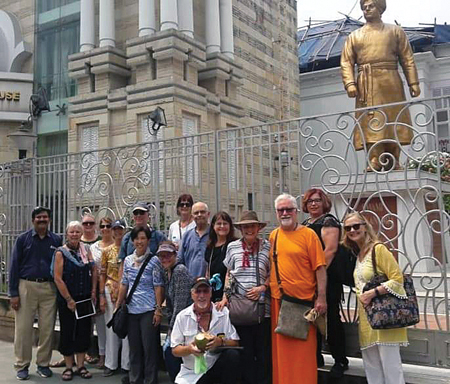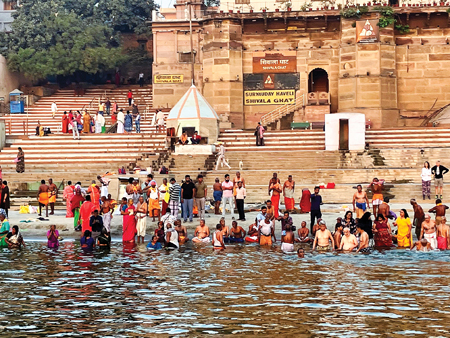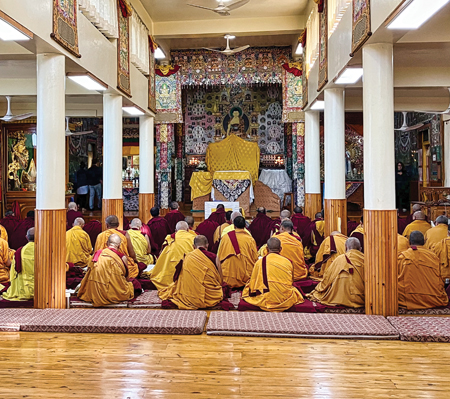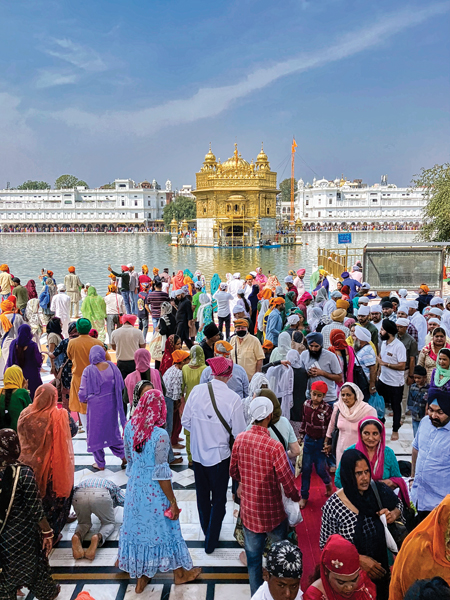Indophile: My Abiding Love Affair with India

It was exhilarating, transformative, illuminating, and sublime. It was exhausting, maddening, stressful, and debilitating. That’s how I remember my month in India last year.
As is now something of a cliché, India is a land of contradictions and extremes.
This was my seventh visit, and the fourth time that I had led a tour of fellow Americans, rooted in the theme of my book American Veda: From Emerson and the Beatles to Yoga and Meditation, How Indian Spirituality Changed the West (2010).
[Left] The author, performing an evening aarti at Parmarth Niketan ashram in Rishikesh.
Each time, our tour itineraries feature places associated with the prominent gurus who came to the West as well as encounters with various swamis, scholars, and other interesting people with something to teach us. Along the way, we visit temples, ashrams, historical and architectural landmarks, and explore the Indian landscape.
The Magic of India
These repeated visits are all part of my attraction to India that began in the 1960s at the movies. As a college student discovering foreign cinema in the art houses of New York City, I viewed, with wonder and delight, the revelatory films of François Truffaut, Akira Kurosawa, Federico Fellini, and others. Then, in one memorable three-day span, my mind was blown (as we said back then) by Satyajit Ray’s Apu Trilogy.
Every element of the trio of films—the exquisite black-and-white images of village and city life, the main character’s arc from childhood to middle age, the tension between tradition and modernity—was gripping and intriguing. But it was the scenes in Benares (now Varanasi) that captivated me. I knew nothing about the ancient city; and the Ganges was just the name of a river to me, not a sacred entity. But something about the way Ray depicted, framed, and revealed the city penetrated me deeply. I knew that one day I had to go there.
 Almost as enchanting as what I saw on screen was what I heard. The trilogy’s score—subtle, unobtrusive, and utterly enthralling—featured string and percussion instruments I’d never heard before. Words like sitar and tabla were not yet in my vocabulary. But a short while later, when Ravi Shankar was befriended by George Harrison and emerged as an unlikely superstar, the sitar became part of the 1960s soundtrack. That’s when I learned that Maestro Shankar had composed the music for the three-part tale of Apu’s life.
Almost as enchanting as what I saw on screen was what I heard. The trilogy’s score—subtle, unobtrusive, and utterly enthralling—featured string and percussion instruments I’d never heard before. Words like sitar and tabla were not yet in my vocabulary. But a short while later, when Ravi Shankar was befriended by George Harrison and emerged as an unlikely superstar, the sitar became part of the 1960s soundtrack. That’s when I learned that Maestro Shankar had composed the music for the three-part tale of Apu’s life.
[Right] The author has led four tours of Americans on a pilgrimage to India on the theme of his book, American Veda: From Emerson and the Beatles to Yoga and Meditation, How Indian Spirituality Changed the West. The group is seen here at the Swami Vivekananda Museum in Kolkata.
By then, India, to me, was more than an exotic tourist destination and much more than a surpris-ing source of world-class art and music. It was the homeland of timeless wisdom that was reformulating how I saw the world and reshaping the contours of my life.
I was young and restless, angry and scared. My discontent had led to a diligent search for answers to the big questions: Who am I? How can I find peace and fulfillment? What’s my place in the universe? Conventional wisdom seemed wrong at every turn and the standard American lifestyle seemed, to quote William Shakespeare, “weary, stale, flat, and unprofitable.” As I drifted to what was called the counterculture, books came my way, and in the works of authors I admired—Joseph Campbell, Aldous Huxley, Somerset Maugham, Herman Hesse, J.D. Salinger—I found admiration for India’s spiritual heritage. That led me to the Bhagavad Gita, the Upanishads, and works by modern swamis, yogis, and Buddhist masters. I took up meditation and supplementary practices, and I never looked back. My life had changed irrevocably.
I’ve been grateful to India ever since for birthing the universal wisdom of Vedanta and Yoga, and for somehow maintaining it through centuries of colonization.

A scene from the sacred Ganga ghats in Varanasi.
The Discovery of India
I had planned to go to India for the first time in 1970 to be trained as a Transcendental Meditation teacher in the Rishikesh ashram, the one that was made famous by the Beatles. To my great disappointment, the program was held in America instead and I spent three months in the Rockies, not the Himalayas. For the next thirty years, every time I hatched a plan to go to India, circumstances inter-vened. I either had the money and not the time or the time and not the money.
Finally, in 2001, I was introduced, at long last, to my spiritual homeland. I spent about a week each in Delhi, Rishikesh, Varanasi, and, along with 30 million other pilgrims, the Kumbha Mela in Allahabad (now Prayagraj), plus a day or two in Khajuraho, Vrindavan, and Agra for an obligatory—and unexpectedly sublime—viewing of the Taj Mahal.
Since then, every trip back has been illuminating and transformative in its own way. And, when I return to the U.S., I’m invariably asked what I’d seen for the first time and how places I had been to before have now changed.
The first question is easier to answer: every Indian location I visit for the first time—from the temple towns and tropical backwaters of the south to the hill stations and ghats of the north, from colossal metropolises to remote villages—shows me stunning new things and also reassures me with comfortable, familiar things.
The second question is more nuanced because India is consistent in its inconsistency and changeless in its constant change. I always say, to start with, that in many ways, India hasn’t changed at all, and that’s very fortunate. The insights of the rishis, the oral and written legacy of the sages, the timeless practices maintained in temples and ashrams—those precious gifts India has given the world live on in all their remarkable diversity.
 The representatives of the various lineages whom I meet continue to uphold and transmit to others the precepts of the sacred texts and the psychospiritual methodologies they favor. And, in the spirit of seva and karma yoga, most continue to direct service projects that benefit the Indian people.
The representatives of the various lineages whom I meet continue to uphold and transmit to others the precepts of the sacred texts and the psychospiritual methodologies they favor. And, in the spirit of seva and karma yoga, most continue to direct service projects that benefit the Indian people.
At the same time, India has changed, most visibly in its sorely-needed infrastructure upgrades: new roads have made long rides more bearable and the new airports are superior to the aging ones in the U.S.
[Left] Visiting a Buddhist monastery in Dharamsala.
I occasionally learn of disturbing developments. It breaks my heart to hear about communal conflict or acts of bigotry and violence directed at Muslims and other minorities in the name of Hinduism. It seems antithetical to the innate pluralism that’s been central to the tradition since the Rig Veda. It is this pluralism that is deeply admired by people like me the world over.
It’s also disturbing to hear about anti-Hindu activities in Kashmir, Pakistan, and Bangladesh, or the coercive and deceptive conversion tactics of Christian missionaries in Tamil Nadu and other areas. I am pained by the reflexive anti-Hindu sentiments of various Indians in the name of modernization with the underlying assumption that ancient spiritual traditions are impediments to progress. That premise, I hasten to point out, has been disproven by the enormously successful adaptation of dharmic teachings to the modern, scientific, ration-al, and technologically-advanced societies of the West.
Change and Continuity in India
On a related note, one trend that has become more troubling with every visit is the blind Westernization of India’s youth. It’s one thing to em-brace technologies like computers and automobiles or to exchange saris and kurtas for jeans and T-shirts, but it’s quite another to go all in for frenzied consumer-ism marked by an office-bound commuter lifestyle filled with alcohol at happy hour, carbonated soft drinks, junk food, and carry-out culture. It is a lifestyle that has wreaked havoc with the mental and physical health of Americans. It was particularly dispiriting, on my recent tour, to find Burger King and Domino’s Pizza shops side by side in Rishikesh, of all places, and to see Coca-Cola commercials on the recently-installed giant screen above the Varanasi ghat where evening aarti is performed.
Ah, but one thing that doesn’t change—and I suspect never will—is the gracious spirit of the Indian people. After imbibing an arresting buffet of experiences, diving deeply into India’s spiritual treasures, learning new practices and exploring new ideas, seeing a stunning array of magnificent sights, the thing our travelers talk about most is the people they encounter.
 The kindness and generosity offered to us by ordinary Indians—who are, with rare exceptions, welcoming, curious, and helpful—are always singled out in our end-of-tour reflections. I always share with our travelers, as part of their orientation, the Indian maxim of Atithi Devo Bhava (the guest is God). By the end of the tour, they’ve seen firsthand just how seriously the Indian people take that adage. They’re invariably deeply moved by the kindness and affability of ordinary Indians, a lived experience that leaves a bigger mark on their hearts than learned discourses and spectacular views.
The kindness and generosity offered to us by ordinary Indians—who are, with rare exceptions, welcoming, curious, and helpful—are always singled out in our end-of-tour reflections. I always share with our travelers, as part of their orientation, the Indian maxim of Atithi Devo Bhava (the guest is God). By the end of the tour, they’ve seen firsthand just how seriously the Indian people take that adage. They’re invariably deeply moved by the kindness and affability of ordinary Indians, a lived experience that leaves a bigger mark on their hearts than learned discourses and spectacular views.
[Right] Amritsar golden temple
I should add that, like most good things, friendli-ness, courtesy, and generosity can be taken too far, providing visitors with endearing stories to tell. My 2014 visit was an 18-city book tour for the Indian release of American Veda. I was not only a guest that time around, but an honored one; and when Indians decide you’re worth honoring, they pull out all the stops. After a week of being overfed and over-entertained, I told my wife that I was going to die of Indian hospitality. I didn’t know how to say “no” to those who insisted on keeping me company at all times, or to the constant offerings of food (especially the endless plates of delectable sweets). I ended up asking the tour organizer to tell those hosting me at each destination that I had diabetes. It was a lie, and I hated to lie, but the strategy worked, and I gained only twelve pounds instead of fifty.
Of course, my tour guests don’t have to deal with such extremes of cordiality, only the occasional group of locals who can’t take enough pictures with their new American friends (especially blonde ones—a rarity in India). What my fellow travelers remember the most are the wide, gleaming smiles; the dark, inquisitive eyes; the sincere offers of assistance and advice; and the humble, heartwarming service. More than anything else, it’s the warmth of the Indian people that makes the heat and dust, the chaos and clamor, the illnesses and the near-catastrophes seem like minor inconveniences. And the travelers have pictures to prove it.
As for me, even though I know by now exactly what to expect, India always manages to take me by surprise. On the last tour—more harrowing than the previous ones because some of our group got diagnosed with Covid-19—I oscillated continuously between the magnificent and the unbearable, the elevating and the depressing, the joyful and the annoying. I returned to the U.S. utterly worn out but somehow exhilarated.
I never want to go to India again.
I can’t wait to get back to India again.
Philip Goldberg is the author of numerous books including the award-winning American Veda, The Life of Yogananda, and his latest, Spiritual Practice for Crazy Times. He co-hosts the Spirit Matters podcast, blogs at Spirituality & Health, and leads American Veda Tours to India. He can be contacted through his website, www.philipgoldberg.com. To comment on this article, please write to letters@khabar.com.
Enjoyed reading Khabar magazine? Subscribe to Khabar and get a full digital copy of this Indian-American community magazine.
blog comments powered by Disqus










